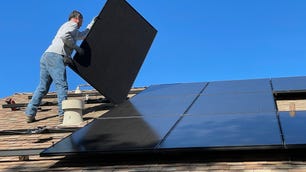
If you’ve seen an individual, company or organization claiming to be powered by green or renewable energy, it’s thanks to renewable energy certificates, otherwise known as RECs.
Climate change is felt on a global level and people are increasingly turning to renewable energy as a solution to displace carbon-emitting fossil fuels. But a large-scale transition from fossil fuels requires worldwide support, including from individuals and groups located in places with no or minimal access to renewable energy sources such as wind and solar. RECs let companies and individuals buy renewable energy, even if they’re located far from solar, wind, hydropower or other renewables
The problem is electricity behaves in a way that makes it difficult to track. Once it’s on the grid, electricity from renewable sources can’t be separated from electricity generated by fossil fuels. RECs are how renewable energy is tracked, making sure the environmental credit goes to only one buyer. Some experts say RECs have helped the rapid spread of renewables in recent years and provide additional income to generators of renewable energy.
Here’s how they work and how to know if they are worth pursuing.
Can solar panels save you money?
Interested in understanding the impact solar can have on your home? Enter some basic information below, and we’ll instantly provide a free estimate of your energy savings.
What are RECs?
You can think of RECs like a gift certificate for renewable energy. While cash can be traded an unlimited number of times, a gift certificate can be redeemed only once. When you redeem a REC (also called “retiring” a REC) you get to claim the environmental benefits of one megawatt hour of renewable energy.
The problem is electricity behaves in a way that makes it difficult to track. Once it’s on the grid, electricity from renewable sources can’t be separated from electricity generated by fossil fuels.
Every time a renewable power source generates one megawatt hour of electricity (about what the average American house uses in a month), it also generates one renewable energy certificate, which represents the environmental benefits of that megawatt hour. While the electricity zips off to power a factory or toaster or street light, the REC stays with the energy producer, until they decide to sell or retire it.
Just as a dollar bill is a tradable commodity that essentially represents the promise, backed by the US Treasury, that it is worth one dollar, a renewable energy credit (REC) is also a tradeable (but non-physical) commodity representing a promise that one megawatt hour of energy was created by a renewable source.
Retiring an REC takes it out of circulation (it can’t be sold again) and allows whoever retires it to claim the environmental benefits of that one megawatt hour.
RECs determine who gets to claim the renewable energy on the grid.
For example, Company A uses solar panels to generate some or all of its energy. Company A chooses to sell all of its RECs to Company B. After offloading its RECs, Company A can’t claim on paper or publicly that it uses renewable energy. Company B — that purchased those REC — can.
A company might purchase RECs to make marketing claims about their eco-friendliness or to meet government-mandated green energy requirements.
How do RECs work?
RECs allow you to track the energy you generate and prove that it comes from a renewable source. Programs differ by state and market, but in theory, if you’re generating renewable energy from solar panels you could claim RECs associated with that energy.
An interesting feature of RECs is that they are distinct from the actual consumable electricity.
“What that means is you’re kind of dividing the product,” said Daniella Gray, head of customer relations for Altus Power, a national solar company. “You’re selling the power or the benefits associated with the power to one customer or group of customers, and then you’re selling the RECs to a separate customer or group of customers.”
In other words, someone with rooftop, grid-connected solar in Albuquerque could sell those electrons to New Mexico’s main utility, PNM, via net metering and also sell the RECs tied to the same electrons to PNM via a REC market. This is sometimes called “unbundling.”
It’s not so straight-forward for an individual homeowner to navigate the REC market, however. You’ll have to hope that your state government or utility has established some sort of consumer program (few have, and some that were established are being discontinued) or go through a broker or a site like SRECTrade. That means the effort isn’t always worth the payoff.
RECs can be bought and sold via these means, but once they are sold, they are “retired” and can’t be sold again. Think about this as the difference between cash and a gift certificate. Cash can circulate and be traded over and over again, but a REC, like a gift certificate, is just a one-time promise of a certain value.
Why buy and sell RECs?
REC prices are determined by supply and demand, which is often impacted by state policy.
Governments around the world and across the US have established renewable portfolio standards requiring that a certain amount of their energy mix derive from carbon-free sources like solar and wind. Many corporations are subject to similar standards or have set their own internal sustainability goals.
All this demand helps drive the growth of renewable energy and markets for RECs, which can help governments and businesses comply with renewable energy standards in lieu of directly installing wind, solar or some other non-polluting source. Companies can buy RECs to meet green goals or standards, while others can install solar panels and sell RECs to earn back their investment quicker. There are different markets for utilities buying RECs to meet government renewable portfolio standard mandates and companies — or even individuals, though it’s uncommon — looking for RECs to meet their own goals or interests. This second market is called the voluntary market.
Some utility customers can sign up for green pricing, where they pay a green pricing premium that the utility uses to retire RECs on their behalf. In 2021, a little over a million utility customers bought RECs this way, purchasing 16.5 million megawatt hours’ worth of renewable energy certificates.
Gray said that right now RECs aren’t typically something most residential customers focus on.
She notes that anyone can participate in the REC market indirectly through community solar programs like those Altus operates. The company sells RECs generated from these projects as one revenue stream that is passed on to subscribers who benefit in the form of lower monthly utility bills.
RECs vs. SRECs
Solar renewable energy certificates, or SRECs, are simply RECs that are explicitly generated from solar power. When state legislators set their renewable portfolio standards, some specify that a certain percentage of the energy mix comes from solar, often called a “solar carve-out.” Tracking this target requires the creation of a solar-specific REC. A solar carve-out can be one way policymakers encourage local utilities and companies in sun-drenched states to source their renewable energy from within the state.
Not all RECs are created equal
One of the main goals of establishing a REC market is the creation of new renewable energy.
A 50-year-old hydroelectric facility still generates RECs and could for some time, but purchasing them doesn’t incentivize building new renewable energy projects, Jeff Swenerton, the communications director for Center for Resource Solutions, told CNET in 2021. Center for Resource Solutions runs the Green-e Energy program, the leader in certifying RECs.
Green-e Energy certifies RECs that are most likely to support renewable energy projects. Certification requires that RECs come from facilities that weren’t built for compliance reasons and are less than 15 years old (or were significantly updated within that time).
“While companies that buy [RECs] from older facilities can make a claim to renewable energy, the reality is their impact is lessened,” Swenerton said.
You can explore certified green energy options here.
Solar panels, windmills, hydroelectric generators without dams, biomass digesters, geothermal stations and some hydrogen cells generate RECs. So renewable doesn’t always mean carbon free. Biomass generates natural gas, which still has associated carbon emissions.
Green-e energy certification is voluntary, Swenerton said. Uncertified RECs can be just as effective, but people can buy certified RECs with confidence.
Pros and cons of RECs
RECs aren’t something that many homeowners interact with directly, but it’s worth investigating if there’s a program that could benefit your specific situation. If there is, consider some of the potential gains and drawbacks.
Pros
- Can be a good way to support renewable energy development
- Can be a source of income in some places with strong programs
- Establish green reputation or meet environmental goals for businesses
- Give a sense of control over your source of energy
- Offset your energy usage without installing any hardware
Cons
- Can be confusing and nearly impossible for an individual to navigate
- Not all RECs are created equal
- Typically tied to intermittent energy sources and can therefore be unpredictable
- Saturated markets have led to low prices for RECs in some places
Is investing in RECs worth it?
RECs can incentivize the development and adoption of renewable energy and the displacement of fossil fuels in the process by assigning a dollar value to the environmental benefits of renewable energy.
RECs have been criticized in the past for being more of a paper-based financial instrument with a tenuous connection to real-world green power generation. Paying attention to things like whether the RECs you buy are incentivizing new renewable energy projects can help ensure RECs have a real-world impact.
Whether they make sense for individual consumers to get involved with buying or selling will depend almost entirely on where you’re located.
For example, the markets for RECs in New Mexico aren’t particularly strong. Speaking from personal experience, trying to sell RECs tied to my little 1.2-kilowatt solar system to a utility like PNM, would generate only around $10 for the entire year.
But Garrett Medelsohn, CEO of Solar Bootcamp, told CNET that other places, such as Illinois and Washington, DC, have more favorable programs.
“SRECs are really sweet to help homeowners save money,” he said, highlighting an Illinois program that gives homeowners who install rooftop solar 15 years worth of SRECs upfront. “So people get a check between $12,000 and $15,000.”
FAQs
What are the different types of RECs?
RECs are exchanged by utilities on a closed compliance market, while companies and individuals can deal RECs on an open voluntary market. Most RECs apply to any sort of renewable energy, while solar-specific SRECs are traded on their own marketplaces.
The value of RECs are determined by the market price on which they’re exchanged.
Originally published Oct. 26, 2021
Correction, Oct. 28, 2021: A previous version of this article misstated the length of time allowed for projects to receive Green-e Energy certification. They can be 15 years old. It was also edited to clarify that Jeff Swenerton said RECs from older projects don’t incentivize new renewable construction but still count for making renewable claims.

